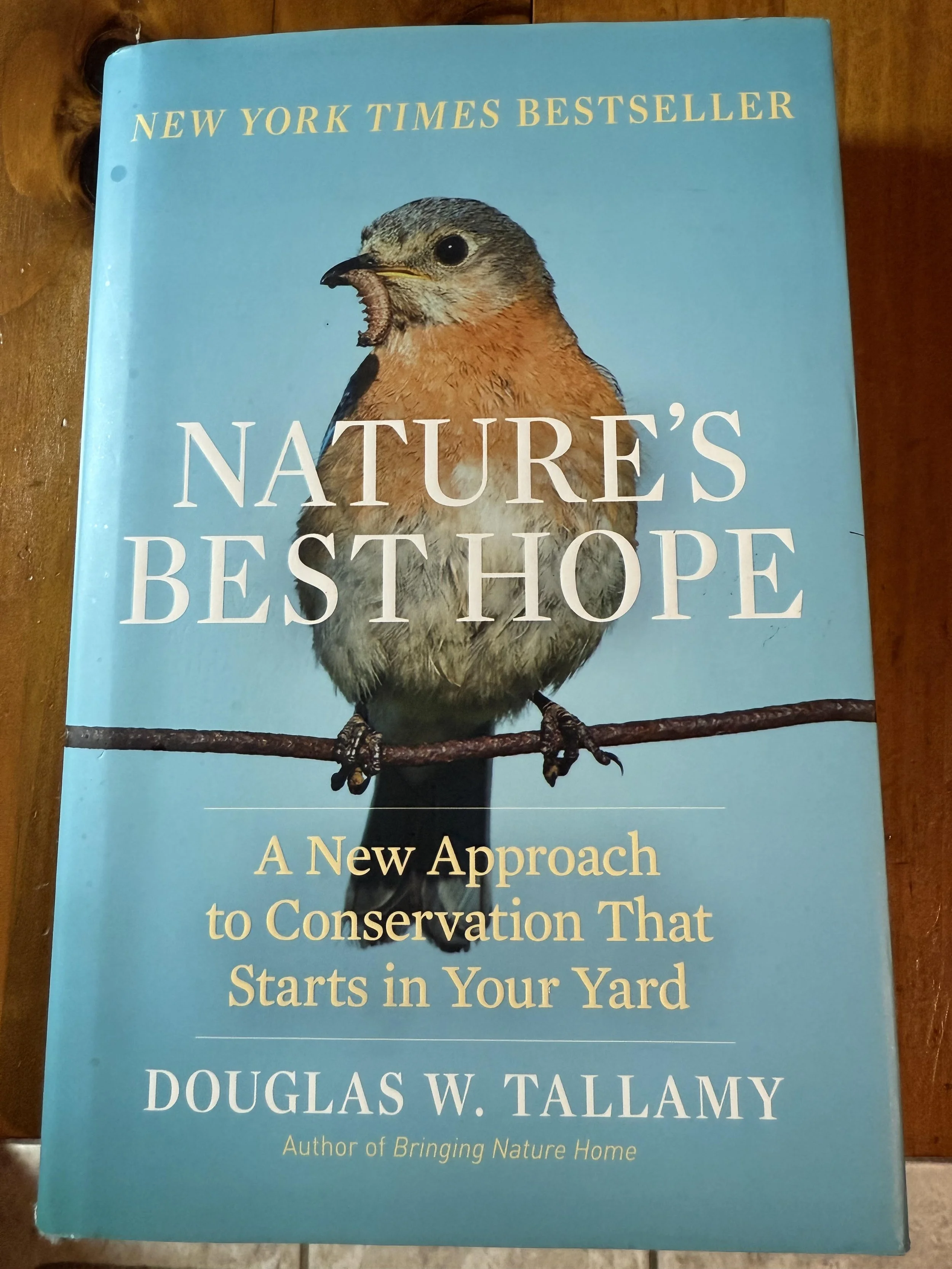The Hachette Book Group description:
From the New York Times bestselling author of Bringing Nature Home comes an urgent and heartfelt call for a new approach to conservation—one that starts in every backyard.
Douglas W. Tallamy’s first book, Bringing Nature Home, awakened thousands of readers to an urgent situation: wildlife populations are in decline because the native plants they depend on are fast disappearing. His solution? Plant more natives. In this new book, Tallamy takes the next step and outlines his vision for a grassroots approach to conservation. Nature’s Best Hope shows how homeowners everywhere can turn their yards into conservation corridors that provide wildlife habitats. Because this approach relies on the initiatives of private individuals, it is immune from the whims of government policy. Even more important, it’s practical, effective, and easy—you will walk away with specific suggestions you can incorporate into your own yard.
If you’re concerned about doing something good for the environment, Nature’s Best Hope is the blueprint you need. By acting now, you can help preserve our precious wildlife—and the planet—for future generations.
From his new initiative, Homegrown National Park, these are some steps you can take.
1. Reduce the size of your lawn.
Turfgrass is biologically useless.
Cutting your lawn in half and replanting with natives will help preserve biodiversity.
2. Remove invasives.
They outcompete natives and lower an ecosystems’s carrying capacity.
Use Google lens to identify invasive plants on your property.
3. Plant Keystone Species.
Top Native Trees for our area are: Oaks, Black Cherry, and Willow.
Top Native Herbaceous Plants for our area are: Goldenrod, Sunflowers and Asters.
Use National Wildlife Plant Finder to find the Keystone species for your area.
This and other resources on Native Plants are listed in the On-Line Resources below.
4. Create Pupation Sites Under Trees.
Identify the tree,
Layout shape of the site at least to the dripline,
Cover area with cardboard and mulch.
Keep the area mulched with a 2-inch layer of leaf litter, trimmings or other organic matter to help the soil remain friable and to block out persistent weeds.
5. Hardscape for Conservation.
Logs and Large Stones: Mark spots for multiple logs and large stones, which serve as pupation sites, hiding places, and shelter for small creatures.
Water Features: Install bubbling water features to provide a reliable, clean source of water for wildlife, including ground-level and elevated birdbaths.
Bare Ground: Designate areas of bare ground for ground-nesting native bees, a crucial component of supporting pollinator diversity.
Shelter for Pollinators: Create specialized shelters for pollinators, such as multiple, small bee hotels rather than one large one, to protect them from predators and diseases.
Window Well Covers: Install covers on window wells to protect small mammals, reptiles, and amphibians from becoming trapped.
6. Reduce/Eliminate Fertilizers and Pesticides
Fertilizers are unnecessary for a healthy ecological garden, as long as the soil is rich in organic matter and native plants are used instead of turf grass.
Leave fallen leaves to decompose and act as a mulch.
Traditional lawns often rely on fertilizers, which can lead to runoff and pollute waterways.
Indiscriminate pesticide use kills beneficial insects, such as pollinators, and are harmful to ecosystems.
Use targeted pest control, like baits for fire ants or mosquito dunks for mosquito larvae, to protect birds that rely on insects for food.
7. Educate and Network with Neighbors
Network with likeminded neighbors-gardening together builds community.
Use signs in your garden to inform friends and neighbors.
Host informational sessions and webinars.
If municipal or neighborhood rules get in your way, work to change them.
Talk to your city council representatives about Homegrown National Park.
Educate young people.
On-Line Resources
Homegrown National Park
https://homegrownnationalpark.org/
National Wildlife Federation- Plant Finder
https://nativeplantfinder.nwf.org
Landscaping with Native Plants
https://www.pa.gov/agencies/dcnr/conservation/wild-plants/landscaping-with-native-plants
National Wildlife Federation- Keystone Native Plants
https://www.nwf.org/-/media/Documents/PDFs/Garden-for-Wildlife/Keystone-Plants/NWF-GFW-keystone-plant-list-
ecoregion-8-eastern-temperate-forests.pdf
PA Invasive Species
http://cedatareporting.pa.gov/reports/powerbi/Public/AG/PI/PBI/PISC%20Invasive%20Species
Common Invasive Plant Species (with pictures)
https://www.brandywine.org/conservancy/landowner-resources/invasive-plants
Sources
Tallamy, Douglas W. Bringing Nature Home: How You Can Sustain Wildlife with Native Plants, Timber Press, 2009
Tallamy, Douglas W. Nature’s Best Hope: A New Approach to Conservation That Starts in Your Yard, Timber Press, 2019.
Tallamy, Douglas W. , How Can I Help? Saving Nature With Your Yard, Timber Press, 2025
Weyenberg, Alex, Homegrown National Park in Your Backyard, Sierra Club , 2022
Wild Herbs with April Punsalan, #26 Ditch the Lawn, Save the Planet: Doug Tallamy’s Blueprint for a Homegrown National Park Feb. 28, 2025 podcast

